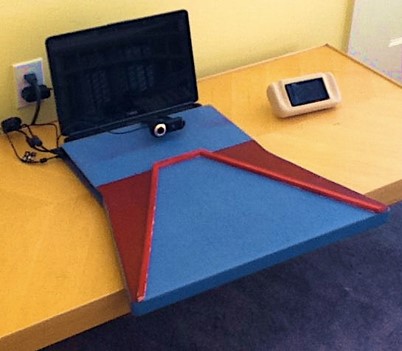If you’re trying to keep yourself and your children safe and sane, you may be considering the idea of virtual play dates over video chat. This has been a research area for me in the past (with many awesome collaborators at Microsoft Research and Georgia Tech) and I wanted to share some thoughts on things that have worked…

Create a Play Stage for Toys. One of the biggest challenges for kids when playing together with toys over videochat is figuring out what their partner can and cannot see. The most frustrating interaction is when a kid holds up a toy to their partner’s face on screen to show it better, only to have that toy go off-camera (it’s not obvious that you have to hold the toy up to the camera!). The way to help is by positioning your camera and screen (laptop, tablet) a little bit further away and marking out an area (e.g., with marker on paper) that’s visible to the partner. This works really well for playing with Legos, toy cars, action figures, dolls, etc. and can also be fun for games like Battleship.

Support Full Body Play with a Larger Screen. While the ideal here would be some sort of a projector-camera-based system, that’s probably not feasible to whip up in most homes. But, putting your camera (webcam, laptop, tablet, phone) under or above your big screen TV and connecting videochat to the TV is pretty good too. Tape a line on the floor to signify where the kids would become off-view of the camera (otherwise they usually try to get too close to the TV). Some fun activities: dance party (obviously!), building blanket forts (one on each side), Simon Says or Red Light Green Light (especially if a parent can lead), two family charades, and that thing that kids do where they make spitty-sounding pew-pew noises at each other while running around (which I’m pretty sure is universal among all kids, so it must be a good time).

Set Up Online Board Games (with a Few Caveats). There are a ton of places where you can find online or app versions of your favorite board games (here’s one recent article reviewing a few). However, a couple of things about this are hard — the inflexible nature of rules in these games can be hard on younger kids (e.g., no taking back a move!) and the interface may have odd quirks that make the gameplay frustrating. So, first, pick a game that everybody knows well, where you typically use conventional (rather than house) rules, and potentially one that’s a bit younger than what your kid can usually play with you (e.g., if they just learned to play Monopoly, that’s not a good time to try to do it remotely). Second, set up a separate screen to the side (e.g., your phone) with a videochat running. Without that connection, it just feels like playing with a computer.
Don’t Underestimate Virtual Spaces as Real Playgrounds. For older kids, exploring a virtual world together can be a really good option! There are many games that are unstructured and have a very cool “playground” feel to them, even if they’re technically a video game. There’s nothing wrong with letting your kids have a play date in Minecraft or World of Warcraft or Club Penguin. Again, my only advice is to make sure you have a videochat connection running in parallel so that kids can talk synchronously and still practice negotiation, turn-taking, and all those other benefits that play provides. A really good challenge to give trying to recreate a physical game in the virtual world (e.g., hide-and-seek, connect four).
Give It Time. My only final piece of advice for whatever strategy you use is to give it a little time. Sit back and observe and see if the kids can come up with their own solutions (as long as the video and audio is working, that is). Let them have the space to be a little bored or have an awkward silence before jumping in. Even if they appeal to you for rescue, say something neutral like “I’m sure you’ll come up with something.” Many of the above ideas and solutions came from bored kids, usually within 5 minutes of awkward boring silences.
By the way, all of the above are also fun for adults to do (except maybe the spitty-sounding pew-pew noises while running around?). Stay safe out there and have fun!

[…] Stay home. Minimize trips to the grocery store. Exercise outdoors. Buy takeout. Stay 6 feet away from others. Video conference, phone calls, and virtual play-dates. […]